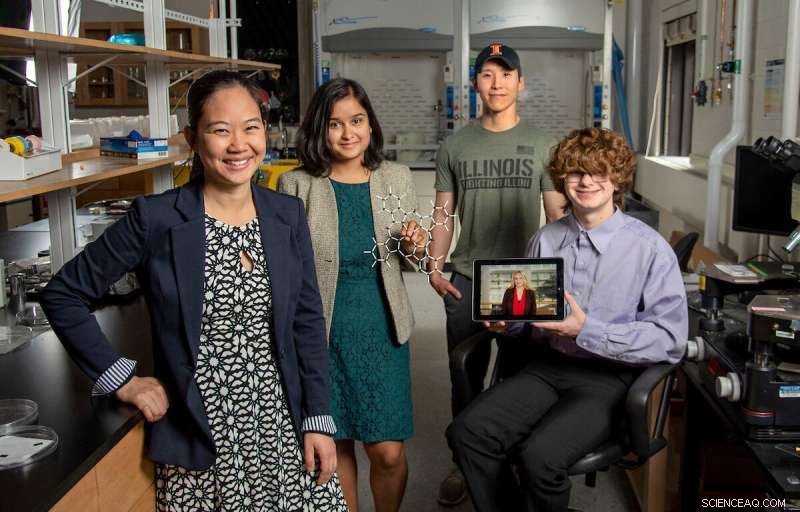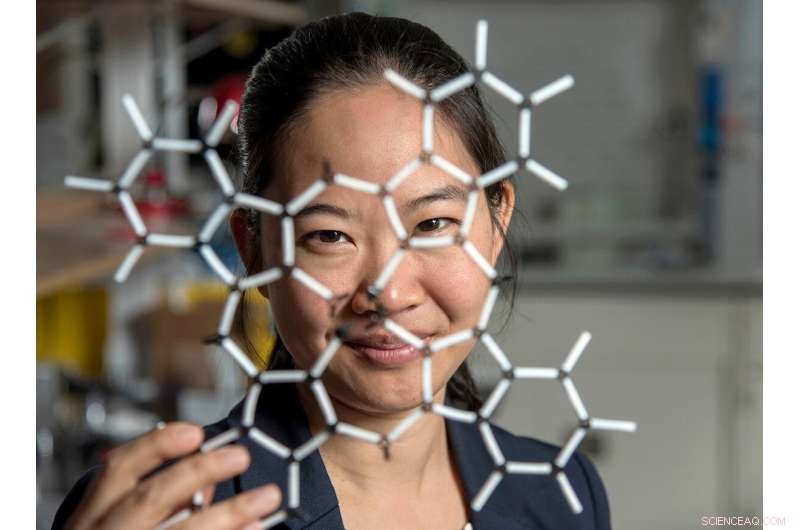
Pinshane Huang, längst till vänster, ansluter, Priti Kharel, andra från vänster, Justin Bae och Patrick Carmichael, längst till höger, vid Materialforskningslaboratoriet. På bilden på surfplattan är Blanka Janicek. Kredit:Heather Coit/The Grainger College of Engineering
En forskningsansträngning vid University of Illinois Urbana-Champaign ledd av Pinshane Huang accelererar avbildningstekniker för att tydligt visualisera strukturer av små molekyler - en process som en gång troddes omöjlig. Deras upptäckt släpper lös potential för att förbättra vardagliga tillämpningar – från plast till läkemedel.
Docenten vid Institutionen för materialvetenskap och teknik har slagit sig ihop med huvudförfattarna Blanka Janicek, en 21-årig alumn och post-doc vid Lawrence Berkeley National Laboratory i Berkeley, Kalifornien, och Priti Kharel, en doktorand vid Institutionen för kemi, att bevisa metodiken som gör det möjligt för forskare att visualisera små molekylära strukturer och påskynda nuvarande avbildningstekniker.
Ytterligare medförfattare inkluderar doktoranden Sang hyun Bae och studenterna Patrick Carmichael och Amanda Loutris. Deras peer-reviewed forskning har nyligen publicerats i Nano Letters .
Teamets ansträngningar avslöjar molekylens atomstruktur, vilket gör att forskare kan förstå hur den reagerar, lära sig dess kemiska processer och se hur man syntetiserar dess kemiska föreningar.
"Strukturen av en molekyl är så grundläggande för dess funktion," sa Huang. "Det vi har gjort i vårt arbete är att göra det möjligt att se den strukturen direkt."
Förmågan att se en liten molekyls struktur är avgörande. Kharel berättar hur viktigt det är genom att ge exemplet med en medicin som kallas talidomid.
Talidomid, som upptäcktes på 60-talet, ordinerades till gravida kvinnor för att behandla illamående på morgonen och visade sig senare orsaka allvarliga fosterskador eller, i vissa fall, till och med dödsfall.
Vad gick fel? Läkemedlet hade blandade molekylära strukturer, en ansvarig för att behandla morgonillamående och den andra orsakade tyvärr förödande, negativa effekter på fostret.
Behovet av proaktiv, inte reaktiv vetenskap har uppmanat Huang och hennes elever att fortsätta denna forskningsinsats som ursprungligen började med ren nyfikenhet.
"Det är så avgörande att noggrant bestämma strukturerna för dessa molekyler," sa Kharel.
Typiskt bestäms molekylära strukturer med indirekta tekniker, en tidskrävande och svår metod som använder kärnmagnetisk resonans eller röntgendiffraktion. Even worse, indirect methods can produce incorrect structures that give scientists the wrong understanding of a molecule's makeup for decades. The ambiguity surrounding small molecules' structures could be eliminated by using direct imaging methods.
In the last decade, Huang has seen significant advancements in cryogenic electron microscopy technology, where biologists freeze the large molecules to capture high-quality images of their structures.
"The question that I had was:What's keeping them from doing that same thing for small molecules?" Huang said. "If we could do that, you might be able to solve the structure (and) figure out how to synthesize a natural compound that a plant or animal makes. This could turn out to be really important, like a great disease-fighter," Huang said.
The challenge is that small molecules are often 100 or even 1,000 times smaller than large molecules, making their structures difficult to detect.
Determined, Huang's students began using existing large molecule methodology as a starting point for developing imaging techniques to make the small molecules' structures appear.
Unlike large molecules, the imaging signals from small molecules are easily overwhelmed by their surroundings. Instead of using ice, which typically serves as a layer of protection from the harsh environment of the electron microscope, the team devised another plan for keeping the small molecules' structures intact.

Pinshane Huang and her researchers discovered how to view structures in molecules, which opens a whole new realm of scientific possibilities. Credit:Heather Coit/The Grainger College of Engineering
How can you temper a molecule's environment? By using graphene.
Graphene, a single layer of carbon atoms that form a tight, hexagon-shaped honeycomb lattice, dissipates damaging reactions during imaging.
Stabilizing the small molecule's environment was only one issue the Illinois researchers had to manage. The team also had to limit its use of electrons, as low as one-millionth the number of electrons normally used, to illuminate the molecules.
Low doses of electrons ensure that the molecules are still moving enough for the researchers to capture an image.
"The way I like to think about it is the molecule doesn't like to be bombarded by higher-energy electrons, but we need to do that to be able to see the structure, and graphene helps dissipate some of that charge away from the molecule so that we can actually get a nice image of it," Janicek said.
Unfortunately, once captured, the molecules were nearly invisible in the image.
"When they take a low-dose image, it initially looks like noise or TV static—almost like nothing is there," Huang said.
The trick was to isolate the atomic structures from that noise by using a Fourier transform—a mathematical function that breaks down the small molecule's image—to see its spatial frequency.
"We took images of hundreds of thousands of molecules and added them together to build a single, clear image," Kharel said.
This averaging approach allowed the team to create crisp images of the molecules' atoms without damaging the integrity of any individual molecule.
"Month after month, week after week, our resolution improved," Huang said. "And then one day, my students came in and showed me the individual carbon atoms—that's a major achievement. And of course, it comes after all this deep knowledge that they have gained to design an imaging experiment and how to unlock data from what looks like nothing."
This collective discovery is paving the way for many more structural molecule imaging findings.
"There's been this whole field of small molecules that have been left out in the cold, so to speak. We're shining a light on how do we get there as a field? How do we make this thing that for us right now is so hard?" Huang said. "One day it won't be—that's the hope."
The Illinois researchers' efforts are the first big step in turning that dream into reality.
"One day, this will be the way we solve the structure of a small molecule," Huang said. "People will simply throw the molecule in the electron microscope, take a picture and be done."
That dream inspires Huang and her Illinois team to keep the course.
"That's potentially life-changing, and we've made it exist," Huang said. "We haven't yet made it easy, but imaging techniques like this will change so much of science and technology." + Utforska vidare